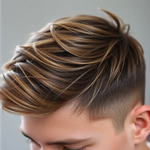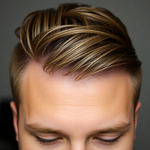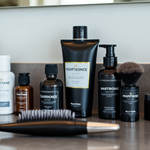
Semi-Permanent Hair Color: The Color Code Minimalists Use to Streamline a Sustainable Men's Capsule Wardrobe
15 September 2025
Share
Struggling to keep your look consistent without buying a ton of clothes? Semi-permanent hair color is a simple, low-commitment way to create a visual anchor for a sustainable men's capsule wardrobe — helping you look intentional every morning with fewer pieces and less waste. This post walks you through the why, how, and practical steps to adopt this approach and keep it low-maintenance.
Semi-Permanent Hair Color: The Color Code Minimalists Use to Streamline a Sustainable Men's Capsule Wardrobe
Think of your hair as the single color note that ties your outfit choices together. When your hair tone is consistent and well-maintained, you can lean on a tighter wardrobe palette and still look sharp. This centerpiece strategy is what minimalists call a "color code": a reliable visual reference that reduces decision fatigue and clothing churn.
Why this works for the modern man
- Consistency reduces choices: With a predictable hair tone you buy fewer clothes that all coordinate.
- Low effort, big payoff: Semi-permanent solutions refresh tone with minimal time and minimal chemical exposure compared with permanent dye.
- Sustainability alignment: Fewer purchases and longer-lasting garments lower your environmental footprint.
- Confidence boost: A unified aesthetic—hair, beard, wardrobe—reads cleaner and more deliberate.
Who this is for
This strategy fits guys aged 18–45 who want to look put-together without constant salon visits: young professionals, students, creatives, and budget-conscious men who value sustainability and simplicity.
How to pick your anchor hair tone
Choosing an anchor tone is the first practical step. Aim for a natural-looking shade that flatters your skin tone and pairs with your wardrobe's neutrals.
- Fair skin: Cooler, ashy tones work well. Avoid too-warm reds that clash with pale undertones.
- Medium/olive skin: Neutral browns and dark chestnuts balance warmth and look natural.
- Warm/darker skin: Rich dark browns and soft blacks provide depth without appearing harsh.
- Grey blending: Choose a shade one to two levels darker than your natural color to blend greys subtly.
Products and formulations that keep it low-impact
Semi-permanent options range from color-depositing shampoos and conditioners to low-peroxide color formulas. These are gentler than permanent dyes and fade gradually, which benefits a minimalist maintenance schedule.
- Color-depositing shampoos and co-washes — great for small tone corrections and weekly upkeep.
- Semi-permanent cream dyes (ammonia-free) — 20–30 minute application, lasts 4–8 weeks.
- Temporary root touch-up sticks and powders — immediate fixes between applications.
Step-by-step: Weekend plan to implement the color-code system
- Audit your wardrobe: Pull out the pieces you wear most. Identify 5–7 core items that define your daily look.
- Choose your anchor tone: Use the guide above or consult a stylist for a one-time color match.
- Buy a semi-permanent product or book a single salon touch-up to establish the tone.
- Schedule maintenance: set calendar reminders every 4–8 weeks for DIY refreshes or a quick salon stop.
- Adjust the capsule: phase out items that clash and keep versatile neutrals (navy, charcoal, olive, beige).
Daily grooming and maintenance routine (10–15 minutes)
- Every morning: quick comb/brush and a drop of leave-in conditioner if hair is dry.
- Weekly: use color-depositing shampoo once to maintain tone; alternate with a gentle sulfate-free shampoo.
- Every 4–8 weeks: apply semi-permanent dye at home or book a 30-minute salon touch-up.
- Beard care: lightly tint stray greys with beard-specific color or a small semi-permanent application for consistency.
- Trim schedule: keep hair and beard trims every 3–6 weeks to support the capsule look.
Styling: coordinate your capsule with your color code
Once your hair tone is set, use it to guide clothing choices. Here are three capsule palettes that pair well with common anchor tones:
- Ashy brown anchor: Charcoal coat, white tee, navy jeans, olive knit, tan boots.
- Dark chestnut anchor: Camel overcoat, deep green shirt, dark denim, brown leather boots.
- Deep black anchor: Black bomber, grey tee, black jeans, white sneakers for contrast.
Beard and eyebrow considerations
Beard and eyebrow tones affect perceived cohesion. If your facial hair has scattered greys, a targeted semi-permanent touch-up or beard tint provides a more unified frame for the face. Use beard-specific formulas designed to avoid skin irritation and longer-lasting results.
DIY vs salon: what to choose
- DIY benefits: Cheaper, fits a minimalist ethos, convenient for routine maintenance. Best for subtle tone shifts and men comfortable with at-home routines.
- Salon benefits: Expert color matching, professional application, low risk of patchiness. Good for first-time color establishment or bigger tone changes.
- Hybrid approach: One salon session to set the anchor tone, then DIY semi-permanent maintenance at home.
Health, safety, and product selection
Semi-permanent products are milder, but safety matters. Patch test 48 hours before use. Avoid overlap with permanent dye chemicals if you plan future changes. For more on safety considerations and common risks, check this overview from WebMD: WebMD on hair dye.
Cost, time, and environmental impact comparison
One of the appeals of this system is measurable savings and lower environmental cost over time:
- Average salon permanent dye session: 1.5–3 hours, higher chemical use, higher cost.
- Semi-permanent maintenance: 20–45 minutes every 4–8 weeks; less chemical intensity and often less packaging waste.
- Wardrobe savings: a tighter capsule can cut clothing purchases by 30–50% annually, lowering production-related emissions and textile waste.
Real talk: common objections and how to handle them
- “I’m worried it’ll look fake.” Pick a shade close to your natural tone and blend gradually. Semi-permanent fades naturally, avoiding stark roots.
- “I don’t want chemicals near my skin.” Choose ammonia-free, low-peroxide products and patch test. Color-depositing shampoos minimize chemical exposure.
- “Too much upkeep.” Semi-permanent products are intentionally low-maintenance—set it and refresh every 4–8 weeks to keep it simple.
How this ties into a sustainable wardrobe strategy
When your grooming is consistent, you buy less. That’s the sustainability loop: stable aesthetics reduce impulse purchases, you choose quality pieces that last, and fewer replacements means less waste. Pair that with conscious product choices (recyclable packaging, concentrated formats, refill options) for a bigger impact.
Menll.com fit: minimalist pieces to match your new color code
If you're building a capsule around your anchor tone, Menll.com offers durable basics and outerwear that pair easily with neutral hair tones. Look for pieces in sustainable fabrics and simple silhouettes. Check Menll.com for essentials and capsule-ready layers to pair with your color strategy: Menll.com Outerwear Collection and this guide to wardrobe building: How to Build a Capsule Wardrobe.
Advanced tips for hairstyle types
- Short crops: Semi-permanent works well—minimal fade line and easy touch-ups.
- Textured/curly hair: Use hydrating formulas and apply color when hair is detangled for even absorption.
- Longer styles: Focus color on roots and mid-lengths for natural depth; avoid full-head saturation unless desired.
Frequently asked questions
- How long does semi-permanent color last? Usually 4–8 weeks depending on product, hair porosity, and wash frequency.
- Will it cover 100% grey? It blends greys well but may not fully cover heavy white hair; choose a shade slightly darker for better blending.
- Can I switch to permanent color later? Yes. Semi-permanent won’t prevent future permanent color, but consult a pro for major changes.
Final checklist: your 30-day plan
- Week 1: Audit your wardrobe and choose/confirm anchor hair tone.
- Week 2: Book a salon match or buy a semi-permanent product for a first application.
- Week 3: Align 5–7 core wardrobe pieces to the anchor tone; donate or sell misfits.
- Week 4: Set maintenance schedule and pick two sustainable hair products (sulfate-free shampoo + color-depositing conditioner).
Wrap-up and one question for you
Adopting semi-permanent hair color as your wardrobe's color code is a minimalist's shortcut to a polished, sustainable look. It trims decision-making, reduces clothing waste, and keeps your image consistent without constant salon time. Which anchor tone are you leaning toward for your capsule — ash, chestnut, or deep black?
Want to explore capsule pieces that match your new look? Browse Menll.com for curated minimalist essentials and sustainable basics.
Suggested meta
Meta title (50–60 characters): Semi-Permanent Hair Color for Minimalist Style
Meta description (150–160 characters): Learn how semi-permanent hair color streamlines a sustainable men's capsule wardrobe—practical steps, product picks, and low-effort maintenance tips.
Suggested URL
menll.com/blog/semi-permanent-hair-color-capsule-wardrobe
Vorheriger Beitrag

Shade Rotation System: Using Semi‑Permanent Hair Color to Maximize a Sustainable Men's Capsule Wardrobe
Aktualisiert am 16 September 2025
Nächster Beitrag

Semi-Permanent Hair Color: The Shade-to-Closet Blueprint for a Low-Waste Men's Capsule Wardrobe
Aktualisiert am 14 September 2025





